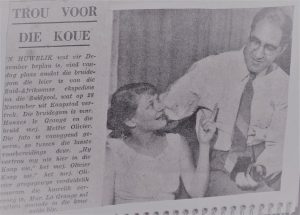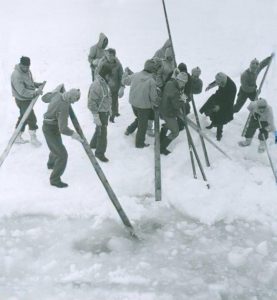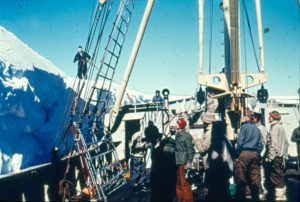60 years ago South African National Antarctic Expedition (SANAE) 1 left from  Cape Town on the 3rd of December 1959 to only arrive on the 8th of January 1960 at Antarctic Ice Shelf. An article about the departure of SANAE 59 has just been posted on the SANAP website. After reading this article, compare that departure with the one below of SANAE 1 (excerpts from the publication, “The White Horizon” by Andre le Roux van der Merwe).
Cape Town on the 3rd of December 1959 to only arrive on the 8th of January 1960 at Antarctic Ice Shelf. An article about the departure of SANAE 59 has just been posted on the SANAP website. After reading this article, compare that departure with the one below of SANAE 1 (excerpts from the publication, “The White Horizon” by Andre le Roux van der Merwe).
“The expedition preparation had been completed in record time – a mere two and a half months for a task which could take years (La Grange 1991). This was largely possible due to the appointment of J.J. (Hannes) La Grange as Expedition Leader. The only member of the team with prior Antarctic experience, La Grange had been one of two South African meteorologists with the 1955-1958 Commonwealth Trans-Antarctic Expedition (TAE) under the leadership of Sir Vivian Fuchs, with the New Zealand Ross Sea support team led by Sir Edmund Hilary. La Grange, the first South African to set foot at the geographical South Pole, was awarded the British Polar Medal and the bronze medal of the Royal Geographic Society, and also the first medal of the South African Academy for Science and Arts for his participation with the TAE (Hibbard 1975).” (John Cooper)
 Leader Hannes La Grange had to say goodbye to his wife of one month.
Leader Hannes La Grange had to say goodbye to his wife of one month.
 “When the 1200-horsepower engine got the propeller
“When the 1200-horsepower engine got the propeller  turning, we could only just make out the faded shapes of friends and loved ones on the docks…..More than a year would pass before we would once again experience the friendliness of the folk on the docks”
turning, we could only just make out the faded shapes of friends and loved ones on the docks…..More than a year would pass before we would once again experience the friendliness of the folk on the docks”
The Polarbjørn departs on a journey for more than a month.
There was no social media such as Whatsapp or Facebook in 1959,

but articles and cartoons did appear in the printed media.
Supplies had to be loaded in time for departure:
“Every day trucks dropped our supplies on the docks. Eventually, 156 tons were stored in the Polarbjørn’s hold. Diesel oil for a tractor and for the generators that keep the equipment and lights at the base going. Lamp oil for the stoves and heaters, and tons of food – enough to last the 10 of us for at least two years in case no ship could get through the frozen ocean to fetch us.”
“Our “Polar Bear” reversed, and a small pilot boat sidled in to push against her bow and help her turn. Forward, backward, and then three blasts of the whistle.”
 “At three o’clock that afternoon, we were stuck in the ice. We all jumped overboard with poles, crowbars and “ice spears” to break the ice and push it out of the way. There was a wild scramble and much laughter as we tumbled back over the gunwale and some of us landed on our stomachs and slid like toboggans over the slippery deck. We had to move quickly to prevent the ice from grabbing hold of the ship once more.”
“At three o’clock that afternoon, we were stuck in the ice. We all jumped overboard with poles, crowbars and “ice spears” to break the ice and push it out of the way. There was a wild scramble and much laughter as we tumbled back over the gunwale and some of us landed on our stomachs and slid like toboggans over the slippery deck. We had to move quickly to prevent the ice from grabbing hold of the ship once more.”
“It was ten to two on the afternoon of Friday, 8 January, 1960 –  36 days since we had said goodbye to the friendly folk on the Cape Town wharf.”
36 days since we had said goodbye to the friendly folk on the Cape Town wharf.”
In commemoration of this first journey – Chris de Weerdt, diesel mechanic of SANAE 1, and Mettie La Grange, wife of leader Hannes La Grange – visited Cape Town harbour on the 3rd of December 2019. During this visit, Chris de Weerdt and Hannes’ daughter, Karen Hechter, toured the S.A. Agulhas II. Visiting the new vessel was a long-time wish of Chris.


(See the article about the launch of “the White Horizon”. The publication has been translated in English from the Afrikaans text. If you are interested in obtaining a copy please contact us at antarcticlegacy@sun.ac.za)



